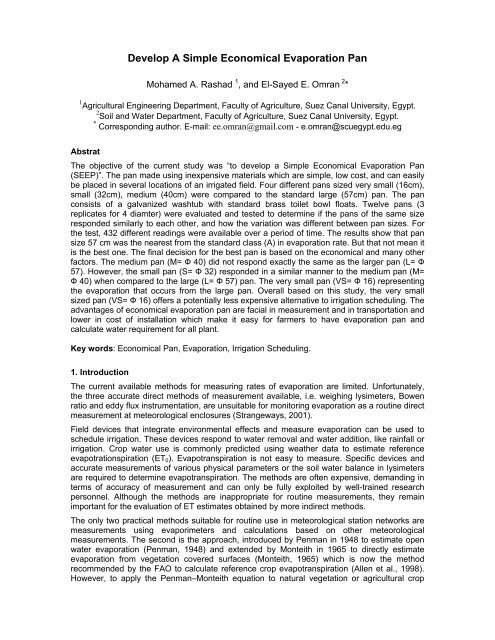poster - International Conference of Agricultural Engineering
poster - International Conference of Agricultural Engineering
poster - International Conference of Agricultural Engineering
Create successful ePaper yourself
Turn your PDF publications into a flip-book with our unique Google optimized e-Paper software.
Develop A Simple Economical Evaporation Pan<br />
Mohamed A. Rashad 1 , and El-Sayed E. Omran 2 *<br />
1 <strong>Agricultural</strong> <strong>Engineering</strong> Department, Faculty <strong>of</strong> Agriculture, Suez Canal University, Egypt.<br />
2 Soil and Water Department, Faculty <strong>of</strong> Agriculture, Suez Canal University, Egypt.<br />
* Corresponding author. E-mail: ee.omran@gmail.com - e.omran@scuegypt.edu.eg<br />
Abstrat<br />
The objective <strong>of</strong> the current study was “to develop a Simple Economical Evaporation Pan<br />
(SEEP)”. The pan made using inexpensive materials which are simple, low cost, and can easily<br />
be placed in several locations <strong>of</strong> an irrigated field. Four different pans sized very small (16cm),<br />
small (32cm), medium (40cm) were compared to the standard large (57cm) pan. The pan<br />
consists <strong>of</strong> a galvanized washtub with standard brass toilet bowl floats. Twelve pans (3<br />
replicates for 4 diamter) were evaluated and tested to determine if the pans <strong>of</strong> the same size<br />
responded similarly to each other, and how the variation was different between pan sizes. For<br />
the test, 432 different readings were available over a period <strong>of</strong> time. The results show that pan<br />
size 57 cm was the nearest from the standard class (A) in evaporation rate. But that not mean it<br />
is the best one. The final decision for the best pan is based on the economical and many other<br />
factors. The medium pan (M= Ф 40) did not respond exactly the same as the larger pan (L= Ф<br />
57). However, the small pan (S= Ф 32) responded in a similar manner to the medium pan (M=<br />
Ф 40) when compared to the large (L= Ф 57) pan. The very small pan (VS= Ф 16) representing<br />
the evaporation that occurs from the large pan. Overall based on this study, the very small<br />
sized pan (VS= Ф 16) <strong>of</strong>fers a potentially less expensive alternative to irrigation scheduling. The<br />
advantages <strong>of</strong> economical evaporation pan are facial in measurement and in transportation and<br />
lower in cost <strong>of</strong> installation which make it easy for farmers to have evaporation pan and<br />
calculate water requirement for all plant.<br />
Key words: Economical Pan, Evaporation, Irrigation Scheduling.<br />
1. Introduction<br />
The current available methods for measuring rates <strong>of</strong> evaporation are limited. Unfortunately,<br />
the three accurate direct methods <strong>of</strong> measurement available, i.e. weighing lysimeters, Bowen<br />
ratio and eddy flux instrumentation, are unsuitable for monitoring evaporation as a routine direct<br />
measurement at meteorological enclosures (Strangeways, 2001).<br />
Field devices that integrate environmental effects and measure evaporation can be used to<br />
schedule irrigation. These devices respond to water removal and water addition, like rainfall or<br />
irrigation. Crop water use is commonly predicted using weather data to estimate reference<br />
evapotrationspiration (ET 0 ). Evapotranspiration is not easy to measure. Specific devices and<br />
accurate measurements <strong>of</strong> various physical parameters or the soil water balance in lysimeters<br />
are required to determine evapotranspiration. The methods are <strong>of</strong>ten expensive, demanding in<br />
terms <strong>of</strong> accuracy <strong>of</strong> measurement and can only be fully exploited by well-trained research<br />
personnel. Although the methods are inappropriate for routine measurements, they remain<br />
important for the evaluation <strong>of</strong> ET estimates obtained by more indirect methods.<br />
The only two practical methods suitable for routine use in meteorological station networks are<br />
measurements using evaporimeters and calculations based on other meteorological<br />
measurements. The second is the approach, introduced by Penman in 1948 to estimate open<br />
water evaporation (Penman, 1948) and extended by Monteith in 1965 to directly estimate<br />
evaporation from vegetation covered surfaces (Monteith, 1965) which is now the method<br />
recommended by the FAO to calculate reference crop evapotranspiration (Allen et al., 1998).<br />
However, to apply the Penman–Monteith equation to natural vegetation or agricultural crop

















